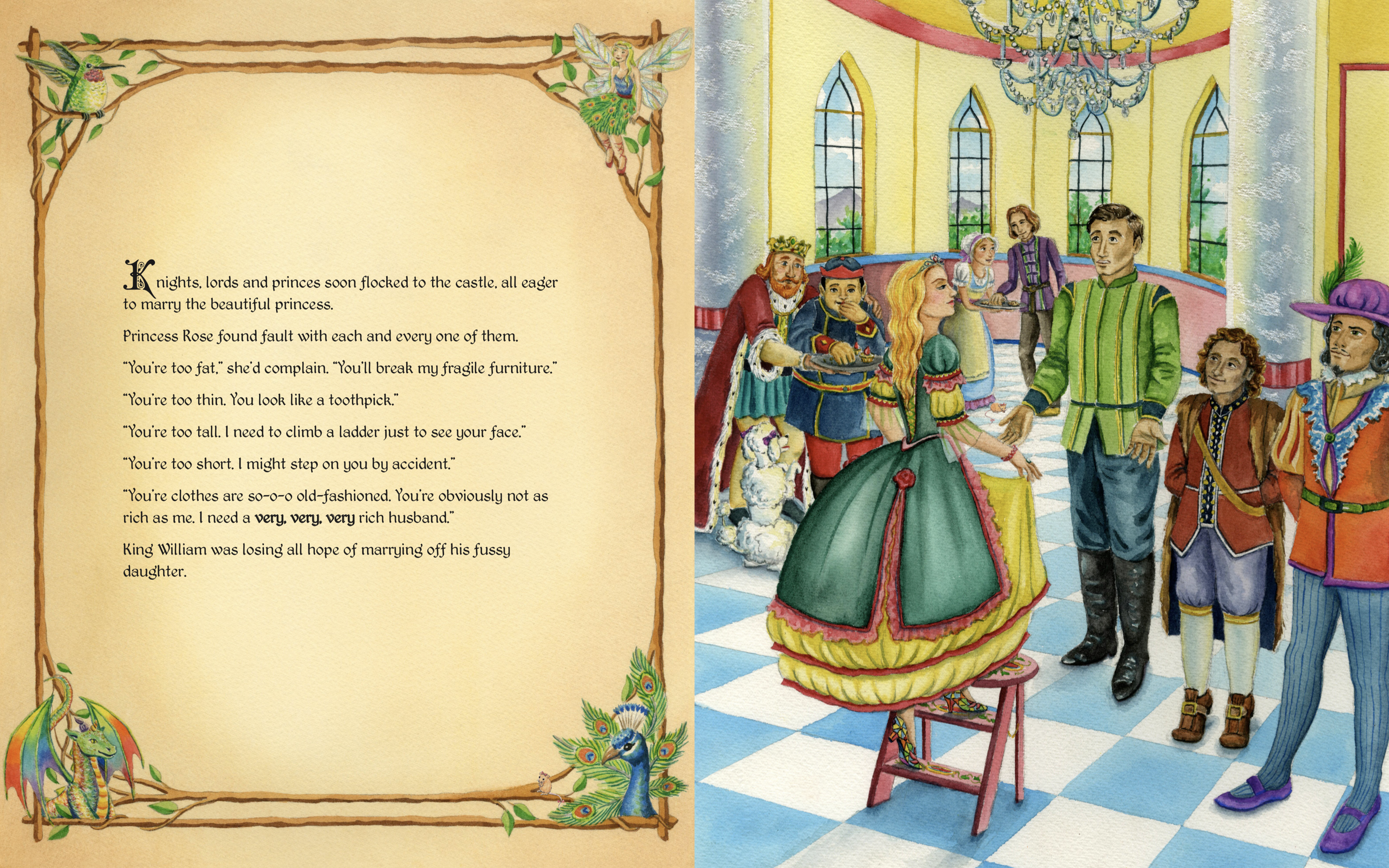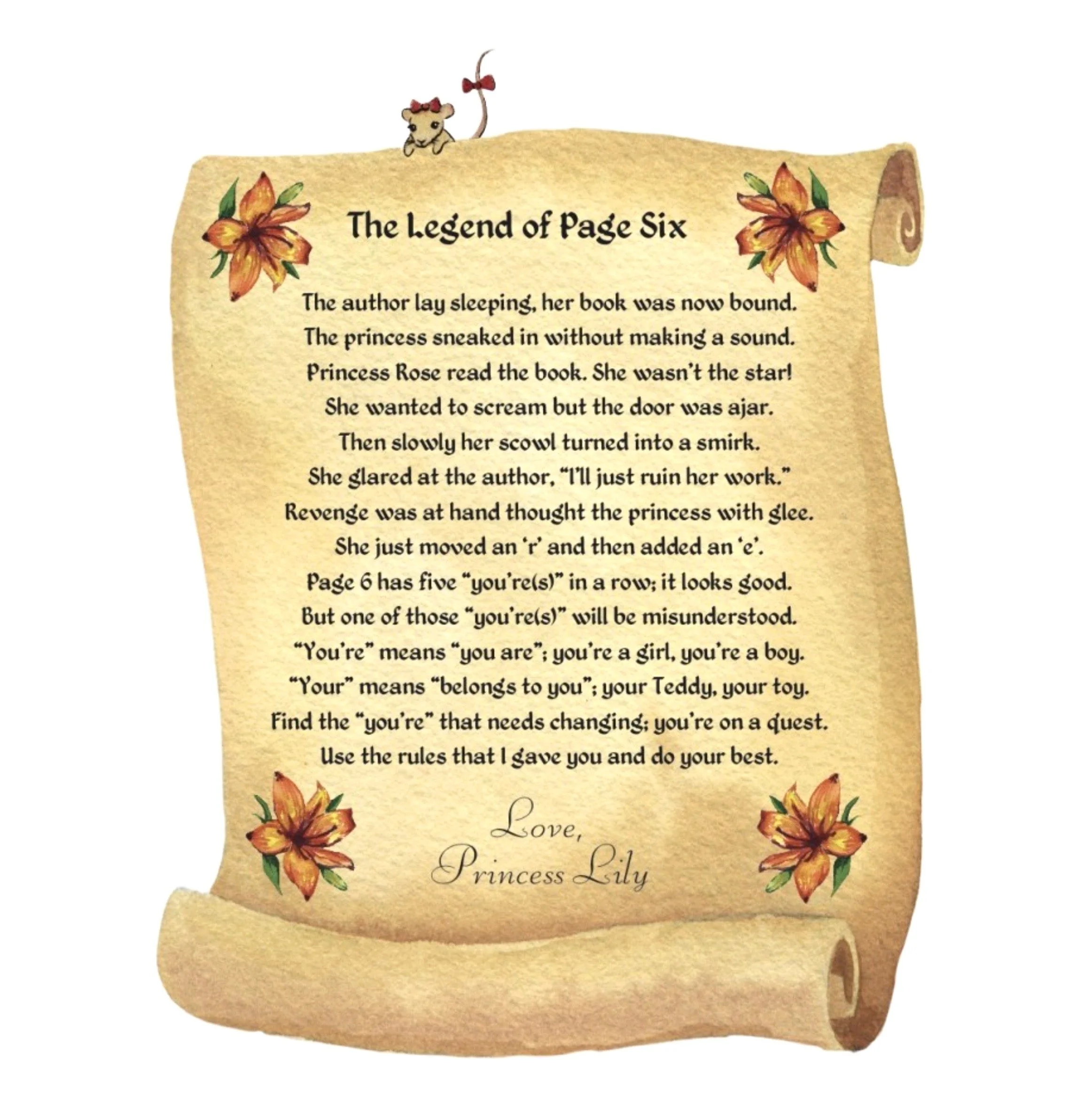The Trials and Tribulations of The Error on Page Six … and the Fix
Why do authors need other people to read our work? If you’re a perfectionist like me, you do multiple drafts of your story. Some of my books have taken over 50 rewrites. By the time you’ve read your story over dozens of times you see what you expect to see, not what’s actually written. So it’s imperative to have multiple people read your work. And even then, you can’t be assured all the errors will be caught.
I’ve learned not to order multiple copies of a book until I’ve seen one copy in print. I learned that the hard way.
I don’t know if I’ve written one book that hasn’t been printed with an error. Now, I don’t think I’ve had more than one mistake per book, which is good since my children’s books are generally only 1,500 words or less. And usually the errors are minor and I can get away with letting it ride until the next printing.
But one time I made an enormous mistake …. enormous. It was in THE ROSE AND THE LILY, a fairy tale about a beautiful princess named Rose. Everyone wants to marry the princess because of her beauty. But like the flower, Rose has a prickly personality. In fact, she’s rude, spoiled and selfish. When a handsome prince shows up, she agrees to marry him IF he can find her the perfect hairpin. He agrees, not realizing just how difficult it will be to please the vain princess. As the story progresses, Princess Rose begins to look less and less pretty in the illustrations because beauty is subjective and the prince is finding Rose less attractive as the story continues.
Have you ever noticed that someone you thought was beautiful/handsome no longer looks so good after a date goes downhill? Or that someone you find plain can becomes prettier/more handsome as you get to know them? That’s what happens when Prince Sterling meets a plain country miss named Lily. The moral of the story is character is more important than beauty. I thought I had written THE PERFECT new classic fairy tale.
Naturally, when I submitted the book for printing, I thought there were no errors. Now, I’m not saying I wrote a book with no errors. But they were found prior to printing. Steve Barancik, one of the people who critqued THE ROSE AND THE LILY, found a major mistake. But it was corrected. Or so I thought.
When Steve received the hard copy I sent him as a “thank you” for his help, he told me the error was still there. I thought he was kidding. Nope. When I checked one of the printed books there it was, like a monstrosity. staring me in the face. How could this have happened?
Megan Stiver, who did the stunning illustrations and the layout for the book, had apparently been having trouble with her computer which was switching changes made to the text back to the original. It failed to keep the correction. (Murphy’s Law: anything that can go wrong, will go wrong.) Unfortunately, none of the people who read the proof caught the mistake. To make matters worse, I myself was lax when checking the final proof. I skimmed over that section because I “knew” it had been corrected. BIG MISTAKE. Soooooo, I ended up with a major order of books containing a grammatical error!
Did you find it? If so, you are one sharp cookie. If not, join the club. Most people don’t register the error. That’s because the page has five “You’re(s)” beginning five sentences. Your eyes just flow down the sentences seeing what they expect to see. People’s brains don’t seem to register the mistake. The first four lines starting with “You’re” (you are) are correct. The fifth line also has “You’re” but it’s possessive and should have been spelled “your.”
Everyone, including Steve, told me not to worry about the mistake since most people wouldn’t notice (and 9/10 people asked to find the error could not find it). BUT the error was not a typo. It was a major grammatical error. How could I, in good conscience, let a book with major grammatical error into the hands of innocent, grammatically naive, children? I just couldn’t.
“You’re” and “your” are words that are frequently used incorrectly. Since children learn through reading, I felt I could not allow the incorrect spelling of this word to remain in a children’s picture book. However, I had printed 2,200 books. I could not afford to just toss them out. What could I do to maintain my integrity but not cause myself a financial loss that I could ill afford?
I ranted. I raged. I swore. I paced. I waved my arms in the air in despair. My husband came out of hiding to say encouragingly, “You’ll think of something” and then closeted himself back in the bedroom.
And then, I had an epiphany. I decided to incorporate the grammatical error into the story. But whatever I came up with would have to be added to the printed book. How was I going to do that? I had to think outside the box. And I did!
I wrote a poem that explained the error on page six. I used humour and Princess Rose’s nasty character and turned the error into a grammar lesson. I had it printed as a sticker and sent it out to everyone who had received the book. Then I put the sticker in the back of each and every one of the remaining 2,200 books I’d ordered. Problem solved!
What do you think of my solution?
I then submitted the correction of the fifth “your” to Lightning Source (my distributor) for my books on-line. But something niggled at my mind. Something just felt “off.” And then I realized … I was missing the perfect opportunity to teach children the difference between “your” and “you’re” when they read THE ROSE AND THE LILY. I resubmitted the book with the correction deleted and the poem inserted in the beginning of the book. Voilà! Children will now get an important grammar lesson when they read THE ROSE AND THE LILY.
If you are interested in purchasing THE ROSE AND THE LILY go to: https://www.susanross.ca/books/the-rose-and-the-lily
P.S. As I was proof-reading this article, I found numerous errors. I hope I caught them all.
How to turn a compliment into an insult: One of my closest friends. who we will call ‘Agnes’ because that’s her name, who I’ve know since we were 12 years old in grade 7, congratulated me on coming up with such a good solution to my dilemma.. She then asked, “Who wrote the poem?” Really? Are you kidding me? I’m a writer. That’s what I do. Well, I can guarantee she never asked me that question again. But just in case…. yes, Agnes, I wrote this blog.


